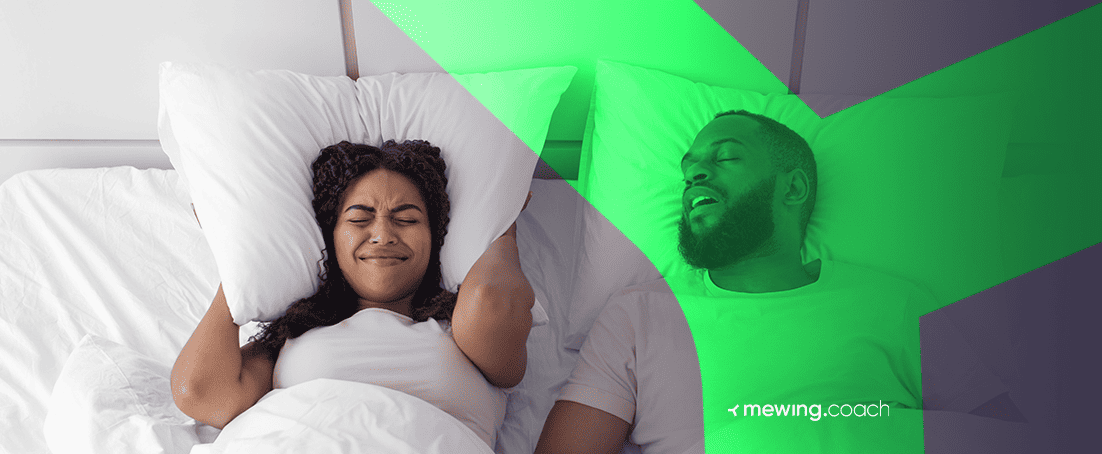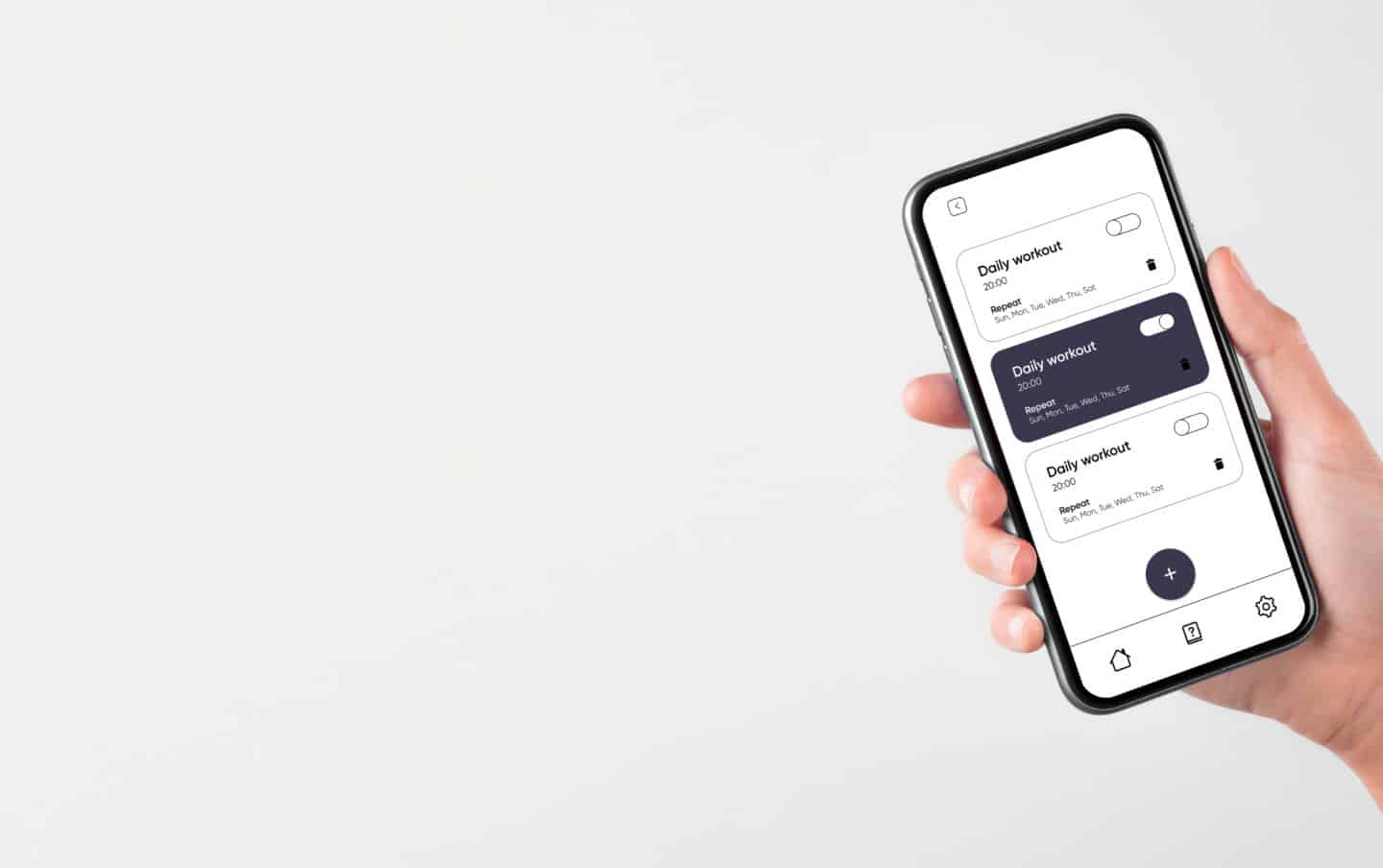Is your snoring disrupting your sleep schedule and depriving you of well-needed energy during the day? Well, you’ll be lucky to know you’re at the right place! Mewing is the answer to all your snoring troubles.
🔎 Let’s hurry and reveal what’s on this page before you nod off:
- 📝 Causes of snoring: A thorough definition of snoring, including facts, causes, and health complications.
- 📖 An introduction to our mewing technique and a guide on mastering a proper tongue posture to eliminate your snoring!
- 💪 What else can mewing help with? If you’ve been keeping your partner up at night with your snoring, newing will finally let everyone get their beauty sleep and even improve your health!
Intrigued? Let’s dig in!

Causes of Snoring
Snoring is the loud, harsh sound heard when air flows through the soft tissues in the throat, causing the soft palate to vibrate. The sound can range from barely audible to an ear-splitting noise that echoes through the walls.
Snoring is a fairly common occurrence. A recent study shows that about 57% of men and 40% of women snore during sleep.
Nearly everyone snores from time to time, but a large portion of people suffer from persistent noisy breathing and gasping for air.
The grating sounds can irritate family members, especially your partner when trying to sleep. Besides being an inconvenience, snoring can also point to serious medical conditions such as sleep apnea and have consequences that disrupt your daily functioning.
So, what causes snoring?
Age
As you age, the muscles around the airway become weaker, and your throat becomes narrower, leading to increased snoring. You can’t reverse the aging process, but you can tone your facial muscles to keep the airway open to breathe freely.
Weight
The buildup of fatty tissue around the neck with accompanying weak muscles plays a part in increased snoring. A heavier neck leads to a smaller airway and a possible airway collapse. Weight loss, regular exercise, and stronger throat muscles are vital to avoiding obstructive sleep apnea.
Build and Gender
Your build and mouth anatomy determine your snoring habits. Men have a naturally narrower air passage than women, so they’re more likely to snore. Also, an elongated uvula or excess tissue in the back of the throat can disrupt the airflow and contribute to snoring.
These traits are inherited, but you can improve the situation by losing weight and doing exercises.
Nasal and Sinus Issues
A blocked nose and inflammation due to a cold, allergies, or irritants in the air lead to nasal breathing. Nasal congestion makes inhaling difficult, often resulting in throat irritation and sleep apnea.
Medications, Alcohol, and Smoking
Consuming alcoholic beverages and taking certain medications relax the muscles and the tongue, which restricts the airflow and causes sleep apnea. In addition, smoking irritates the linings of the nose and throat, which can lead to swelling, congestion, and obstructive sleep apnea.
Your Sleep Position
Sleeping on your back helps the throat relax and blocks or narrows the airway. Sleeping on the side (the left side specifically) can help reduce the chances of developing sleep apnea.
Obstructive Sleep Apnea
In some cases, snoring may signify a serious health issue called Obstructive Sleep Apnea or OSA. Not everyone who snores has OSA, but everyone with OSA snores loudly.
Regular snoring doesn’t interfere with your sleep quality. But OSA means interrupted snoring with pauses in breathing and then loud gasps for air as you continue to breathe again.
As a result, oxygen levels fall, and the brain wakes you up to take a breath. This constant fighting for air will rob you of deep, restful sleep and can be a risk factor for cardiovascular disease.
Healthy adults need 7-9 hours of sleep a night, and obstructive sleep apnea may cause sleep deprivation. Decreased quantity and quality of sleep will cause daytime sleepiness and fatigue. Also, people who don’t get enough sleep do not perform well in memory and learning tasks.
A good night’s sleep is key to good health as it allows the body to recover from illness and injury. Prolonged sleep deprivation is linked to health problems such as obesity, diabetes, and heart complications.
But don’t worry. You can rest easy and sleep like a baby with the help of our Mewing Coach. Mewing is a simple technique that will help you sleep the night away and wake up refreshed, ready to tackle any task the day throws at you.
Let’s see how it works!
How to Get Rid of Snoring With Mewing
Mewing is the latest trend taking over the world of health and wellness. It was started by British orthodontist John Mew and his son Mike Mew who realized the potential benefits of these exercises.
Mewing means maintaining proper tongue posture. Many people do not realize that the tongue’s right position is against the mouth’s roof. They keep the tongue low, towards the lower jaw, thus creating health problems, including snoring and sleep apnea.
The mewing health benefits are many, ranging from a strong jawline and attractive face shape to reduced jaw pain and improved breathing patterns. Mewing can help correct speech impediments and crooked teeth and improve facial structure.
The way you snore reveals the reason behind it. If you snore with your mouth closed, it is related to a problem with your tongue. Open-mouth snoring indicates problems with the soft palate. The mewing technique tackles both.
Learn to Mew With Our Mewing App
The Mewing.coach app is designed to help you position the tongue correctly and exercise the facial, throat, and neck muscles that keep the airflow tight and open. By following the mewing instructions you will learn how to mew properly and exercise your way to a quiet night of deep, restoring sleep.
When you reach the app, make sure you do the quiz first. It gathers information about all the problems you might have, including snoring. Answer the questions without hesitations because the data is used to design a personalized treatment program just for you!
You won’t need to buy any equipment or expensive, uncomfortable devices you must wear during the night. You can do the facial exercises anywhere and anytime during the day and reap the benefits at night.
Your personal plan will instruct you on the type and length of exercising depending on your age, weight, and issues. It even takes into account face shape and teeth alignment to provide you with the best plan to strengthen your mouth and airway muscles.
With only 10 to 20 minutes of mewing exercises daily, you can say good night to mouth breathing, snoring, and sleep apnea.
How Does Mewing Help With Sleep Apnea?
So, how can mewing fix sleep apnea?
Weak muscles around the airway and a loose tongue make it more likely for a person to snore and experience sleep apnea. Exercising to strengthen the mouth and throat muscles can prevent this. In addition, a properly positioned tongue will help you breathe freely.
Practicing regular mewing will force the tongue to stay up against the palate, thus opening the airways. You can maintain this tongue posture during the night as well.
Mewing is a DIY method that will help you tone the throat and neck muscles to ensure more air flows through the nasal passages. It is a physical treatment that will relieve sleep apnea symptoms and grant you and your partner much-needed restorative sleep.
It does. There are thousands of recounts of how mewing has helped people deal with different problems ranging from a receding chin, facial symmetry, and body posture to breathing and snoring.
It has been used for decades to treat orthodontic problems without invasive surgical procedures, during which we have witnessed a multitude of satisfied mewers.
And it is now available to you through our Mewing.coach app – only a click away!
How Long Does It Take to Get Rid of Snoring While Mewing?
Mewing achieves impressive results in reducing snoring and sleep apnea in a very short time. As the muscles tighten and the tongue is lifted, you will see immediate improvements in sleep quality and noise reduction.
That said, learning the correct tongue position and maintaining it at night can take some time. You will have to change a bad practice and turn it into a life-long good habit. But with time and regular exercises, correct tongue posture will come naturally to you.
And the best thing about mewing is that you can start exercising at any age!
How to Prevent Snoring Recurrence
To prevent a snoring recurrence, you must follow the plan of exercises designed by our Mewing Coach and stick to the routine.
You should practice mewing daily and keep the required length and intensity of exercise. It is the same as building other muscles in your body. Once you stop working out, they lose their tightness and elasticity!
Also, you must do the technique correctly to achieve positive results. Check out some common mewing mistakes that can slow down the process and avoid them like the plague!
If you show dedication and commitment, the results will be inevitable.
Other Snoring Treatments
You can try other treatment options to assist the mewing technique and produce results much faster. They include adopting healthy habits and taking good care of yourself:
Make Changes in Your Lifestyle
Lose weight by having a balanced diet and exercise. Less fatty tissue around the waist and neck will reduce snoring.
Avoid certain medications and alcohol before bed to prevent the throat muscles from loosening. And stay healthy and resolve any problems with allergies and sinusitis!
Cold Medications
Cold medications, nasal strips, and ointment oils relieve nasal congestion and help you breathe freely. When you have a cold or the flu, it is important to keep nasal passages open, so use a humidifier, a saline spray, or a neti pot.
Change Your Sleep Position
Try to sleep on your side or stomach because sleeping on your back is one of the biggest causes of snoring and sleep apnea. The position will pull the weight of the tongue down, blocking the airway and causing pauses in breathing.
Try using positioning pillows to help you keep your body on your side. Place a heavy pillow behind your back to prevent you from rolling over on your back.
You can also try elevating your head. Use an extra pillow to keep your back upwards in an almost sitting position. It will remove pressure from the throat and open nasal passages.
When Should You See a Doctor About Snoring?
Snoring can be a sign of serious medical issues like sleep apnea. If left untreated, it can further complicate your health problems.
You should see a doctor if you notice these symptoms and if they persist for a longer period:
- Pauses in breathing during sleep
- Gasping for air
- Restless sleep and frequent waking up
- Chest pain
- Daytime sleepiness
- Difficulty concentrating
- Morning headaches
- Sore throat upon awakening
- High blood pressure
- Extremely loud snoring that disrupts other people’s sleep.
Mewing is the best way to prevent sleep apnea. It’s simple and natural and promotes fitness and overall health.
Don’t waste another night! Mewing.coach will help you get quality sleep and feel refreshed in the morning!





